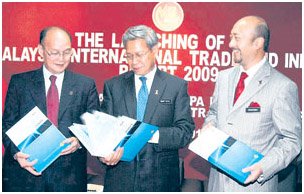Tag Archives: Services sector
Malaysia felt the impact of the global financial crisis, but through sound policy and hard work began to emerge from the crisis at the end of 2009
The world economy in 2009 underwent a major financial crisis. While the U.S., Europe and Japan were hardest hit, Malaysia did not escape economic contraction, but it was among the first countries to show signs of recovery due to the Government’s timely stimulus measures and sound fiscal policy.
The U.S. experienced a 2.4% contraction in real GDP, Europe’s economy shrunk by 4.1% and Japan saw a 5.2% contraction.
World total merchandise trade was down 23% in 2009, and total commercial services trade declines by 14%.
ASEAN saw slower GDP growth of 1.3% in 2009, compared with 4.4% growth in 2008.
Malaysia’s economy shrunk in the first three quarters of 2009, but grew by 4.4% in the last three months of the year.
Malaysia’s trading volume fell in 2009, in line with the global slowdown, but experienced much smaller...
Read More

2325 Views

Media Statement by:
Dato’ Sri Mustapa Mohamed
Minister of International Trade and Industry
Strong FDI Performance for the First Nine Months of 2011
1. Malaysia’s Foreign Direct Investment (FDI) for the first nine months of 2011 was recorded at RM26.4 billion compared with RM18.6 billion for the same period in 2010 indicating a 42 per cent growth. This is based on the latest figure released by the Department of Statistics, Malaysia (DOSM). For the record, total FDI for the whole of last year was RM29.3 billion, while in 2009, total FDI was RM5.0 billion.
2. Based on the FDI flows for the first nine months, it is likely that this year’s total FDI will exceed last year’s figure.
3. While the FDI inflows for Q1 and Q2 2011 were strong which stood at RM10.1 billion and RM11.07 billion respectively, the inflow of FDI in Q3 moderated to RM5.17 billion. This is partly due to weaker external economic conditions, especially in the Euro Zone and the...
Read More

271902 Views
Services sector is new engine of growth
by: Dato’ Sri Mustapa Mohamed
THE services sector is overtaking manufacturing as the main contributor to economic growth. This will have vast implications on where people are going to find work and what skills they will need to get employed.
The government’s growth target is very clear: To become a developed nation by 2020. Using a World Bank definition, that means having a per capita income of RM49,500 (US$15,000) by the end of the decade. The per capita income level in 2010 was RM23,100 (US$7,000).This is an ambitious target and requires gross domestic product (GDP) growth of at least 7 per cent per year.
Historically, the country’s growth had been led by manufacturing. But when the government reviewed its economic policy last year, it realised that this may not be the case for much longer.
For two reasons. In developed economies, the services sector is usually the biggest contributor to economic output.
Last year,...
Read More

1441 Views
KOTA BAHARU, March 1 (BERNAMA) — ASEAN economic ministers (AEM) today wrapped up their two-day retreat here with a steady progress made towards implementing the ASEAN Economic Community (AEC) Blueprint, particularly key measures prioritised by member states.
As the regional grouping moves towards the tail-end of the AEC implementation, it has progressively removed trade obstacles such as Non-Tariff Barriers (NTB), which are a clear impediment towards the realisation of the AEC.
“There are a number of highlights (achieved) during this retreat. We’d talked about NTBs, listened to reports on the progress of the economic integration, and spent a lot of time on the Regional Comprehensive Economic Partnership (RCEP),” International Trade and Industry Minister Datuk Seri Mustapa Mohamed told reporters on the final day of the two-day 21st ASEAN Economic Ministers’ Retreat (AEM) here, Sunday.
Mustapa, who chaired the retreat, said eliminating non-tariff barriers is very...
Read More

1207 Views


 2325 Views
2325 Views